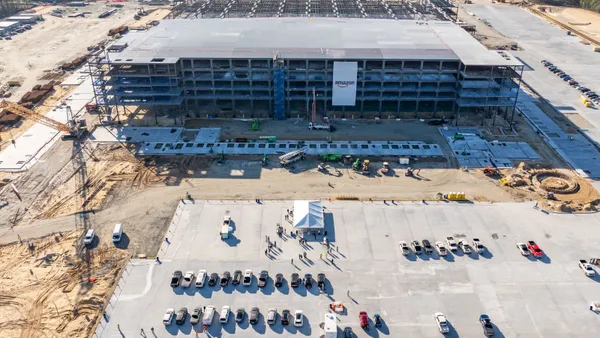Dive Brief:
- Amazon's new north Houston fulfillment center, a $136 million, 855,000 square-foot warehouse, will deploy orange robots by the dozen to carry books, electronics and toys to staffers for quick shipping, the Houston Chronicle reported.
- Contrary to common fears, the addition of the robots will enable the company to provide jobs for 2,500 new workers to staff and run the warehouse. Amazon's presence in Texas is considerable with its addition of a seventh warehouse. In part because of their presence, the company has been granted a 10-year tax break worth $180,000 annually.
- With its stock now worth $1,000 per share, Amazon has announced plans to hire 100,000 full-time U.S. workers within the coming 18 months in pursuit of its goal to capture half the e-commerce market by 2019.
Dive Insight:
Contrary to previous predictions regarding Amazon and its growing reliance on robots, its implementation of mechanical assistants has not caused a job shortage for people in the workforce.
In December, The Seattle Times announced that Amazon had increased its robot staff by 15,000 at 20 fulfillment centers, marking a 50% increase in non-human workers. While that statistic initially raised questions about Amazon's future hiring plans, with the new Houston fulfillment center, Amazon in fact more than doubled its hiring expectations, moving from an initial 1,000, to 2,000, then finally to 2,500.
While picking and sorting tasks remain an unvarying part of fulfillment center work, the knowledge that a robot can work cooperatively with a human to abbreviate prep time for shipping is encouraging, particularly since consumers now have a high expectation for expediency in their orders.
Lastly, while Robert Fiederlein, the Houston district's vice president for strategic planning and development, describes the area as working class, the skills acquired by those working in tandem with robots could potentially be transferred into more complex logistics roles, whether at Amazon or elsewhere. In other words, not only is the addition and reliance on robots bringing new jobs into the economy, but they are also potentially adding a transferable skill set to workers — during a period where the talent gap is significant — that can be transferred to other industries as well.













